Geology
The rock cycle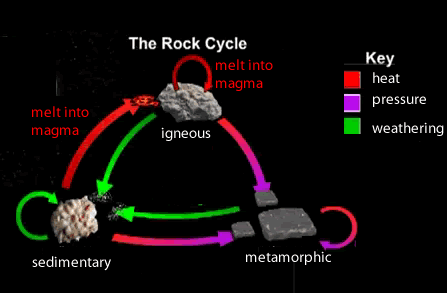
Igneous Rocks
Igneous rocks are those that solidify from a molten or partially molten state. These rocks are characterized as either extrusive or intrusive.
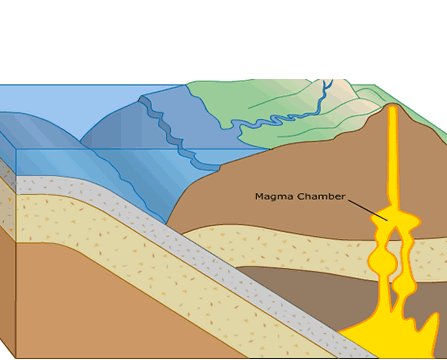
Extrusive Rocks
Extrusive igneous rocks solidify from molten material that flows over the earth’s surface (lava). Extrusive igneous rocks typically have a fine-grained texture (individual minerals are not visible unless magnified) because the lava cools rapidly when exposed to the atmosphere, preventing large crystal growth.
When liquids are allowed to cool slowly the molecules have time to align themselves carefully into position to produce large pure crystals. When cooled quickly, however, the molecules quickly combine with each other not only forming smaller crystals but trapping impurities as well.
Common extrusive rocks are basalt, andesite, and rhyolite.
Intrusive Rocks (plutonic)
Intrusive rocks form from molten material (magma) that flows and solidifies underground. These rocks usually have a coarse texture (individual minerals are visible without magnification), because the magma cools slowly underground, allowing crystal growth. Common rock types within the intrusive category are granite and diorite.
The difference between diorite and granite are not obvious to the untrained eye. Diorite, however, is primarily composed of feldspar and various dark-colored minerals, which explains its black coloring. Granite is composed of four materials: feldspar, mica, quartz and hornblende minerals. These minerals themselves come in a variety of forms, giving granite a much larger variety than diorite.
Sedimentary rocks
Sedimentary rocks are formed when particle accumulate in sea beds and lakes and form layers that are piled one on top of the other. Thus, in any sedimentary rock, a given layer must be older than the layer on top of it. This allows us a way to interpret Earth's history, because at any one location it indicates the relative age of the rock layer and hence the age of fossils found in them.
Erosion and deposition play a key part in the formation of sedimentary rocks. Wind, water, ice, and chemicals break down existing rock into sediment that is then transported and deposited by wind, water, and glaciers. Biological weathering also takes place where plants, bacteria and fungi grow on the rock and over time act to breakdown the rock into fine sediment.
As sediment accumulates with time (millions of years) it becomes compacted and cemented (lithified), eventually forming rock. The rock is then pushed deep under the crust of the Earth, due to plate tectonics, compressed under huge pressure to form denser harder rock known as sedimentary rock. Types of sedimentary rocks include:
Shale: Shale is lithified clay and consists of layers that typically break into thin sheets.
Sandstone: Sandstone is composed of cemented sand grains and is the cliff-forming rock commonly seen in Arnhemland in the Northern territory of Australia..
Limestone: Limestone is composed of more than 50% calcium carbonate (calcite). The remainder of the rock may contain fine rock fragments, clay, quartz, and seashells. Often fossil shells can be seen in the rock.
Conglomerate: Conglomerate is well-rounded gravel in a matrix of sand, clay, and natural cementing agents. Such rocks are often found in Arnhemland and indicate the speed of rivers that deposited the sediment.
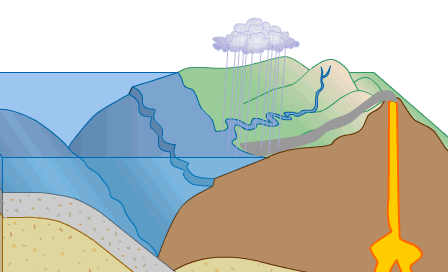
Metamorphic Rocks
Metamorphic rocks are any rock type that has been altered by extreme heat, pressure. Formation of metamorphic rocks does not involve melting of the rock.
Slate: Slate is fine grained, dense, and brittle and is a metamorphosed form of shale, as shown on the right.
Gneiss: Gneiss is a metamorphic rock in which the foliation results from a layering of different mineral groups, which give this rock a banded look of dark (mica) and light (quartz and feldspar) minerals.
Quartzite: Quartzite is typically a metamorphosed form of sandstone. Unweathered quartzite has a “sugary” looking surface. Individual quartz grains are deformed, interlocked, and fused together. When the rock breaks, it typically breaks through the grains.
Marble: Marble is metamorphosed limestone. The calcite crystals in marble are large and interlocking, forming a dense crystalline rock.
Coal is another type of metamorphic rock, largely, formed from the remains of plants and subjected to great pressure and heat.
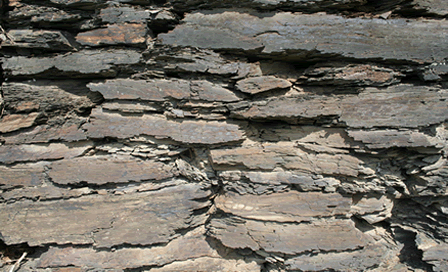
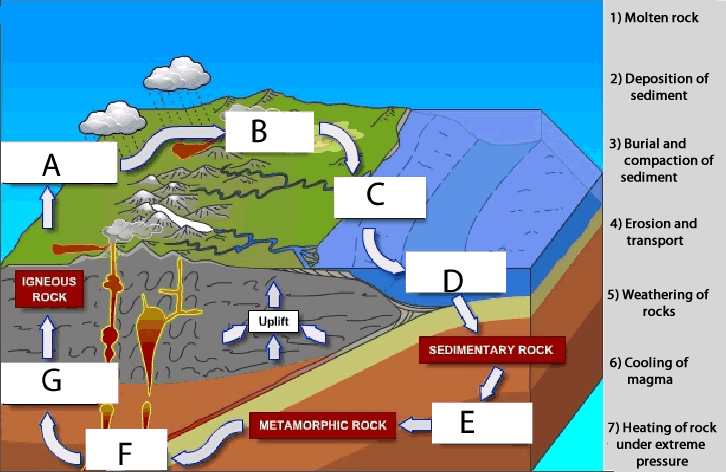
Consider the diagram on the left. Using the terms given fill in the chart.
Solution